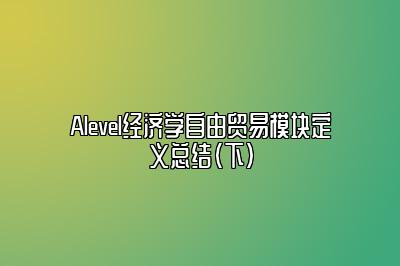Alevel经济学自由贸易模块定义总结(下)
2025-12-24 04:34:56 浏览量:0次

经济学的学习过程中,大家一定不要忽视对专业定义和相关解释的记忆,这些不仅是组成课程的重要部分,更是可以用作论文写作素材的资源。以防大家在写论文时有思路没内容的痛点,小编为大家整理了中英对照版本的Alevel经济学模块定义汇总,本篇是自由贸易版块的下篇,上篇可在本站搜索阅读哦~
Trade barriers 贸易壁垒
It should be obvious that when an economist refers tofree tradehe is referring to international trade without trade barriers (i.e. trade 'free' of barriers). In the final Learn-It of this topic (called 'The case against free trade') the controversial issue of protectionism is covered. Some countries feel they need to 'protect' their domestic industries (and jobs) from foreign competition. They do this by using certaintrade barriers. The more well know is thetariff, which is a tax on imported goods and services.
很明显,当经济学家提到自由贸易时,他指的是没有贸易壁垒的国际贸易(即 "无 "壁垒的贸易)。在本专题的最后一个学习内容(称为 "反对自由贸易的理由")中,涉及到保护主义这一有争议的问题。一些国家认为他们需要 "保护 "其国内产业(和就业)免受外国竞争。他们通过使用某些贸易壁垒来做到这一点。比较知名的是关税,它是对进口货物和服务的一种税收。
Why is free trade a good thing? 为什么自由贸易是一件好事?
The extensive analysis above shows how trade between countries is always a good thing. One would assume that the USA can make most things more efficiently than, say, Mexico (one of its neighbours). But the analysis above suggests that it is still in the interests of both the USA and Mexico that specialization and trade occurs.
上面的广泛分析表明,国家之间的贸易总是一件好事。人们会认为,美国可以比墨西哥(其邻国之一)更有效地制造大多数东西。但上面的分析表明,专业化和贸易的发生仍然符合美国和墨西哥的利益。
Surely, then, it follows that anything that disrupts free trade between countries, such as tariff and non-tariff barriers is a bad thing.
那么,可以肯定的是,任何破坏国家间自由贸易的行为,都是一件坏事。
The World Trade Organization (WTO) 世界贸易组织
The WTO is the world policeman for matters associated with trade. It used to be called theGeneral Agreement on Tariffs and Trade (GATT). The major industrialized countries signed this agreement straight after the war. Its purpose, in particular, was to reduce the use of tariffs around the world. Their ultimate objective was the elimination of all tariffs resulting in free trade around the world. It was very successful, reducing tariffs (on average) from around 40% after the war to fewer than 5% in the 1990s.
世贸组织是与贸易有关事项的世界警察。它曾经被称为关税与贸易总协定(GATT)。主要的工业化国家在战后直接签署了这项协议。它的目的,特别是,是为了减少世界各地的关税使用。他们的最终目标是消除所有的关税,从而实现全世界的自由贸易。它非常成功,在战后将关税(平均)从40%左右减少到1990年代的5%以下。
GATT consisted of a number of 'rounds' where ministers and civil servants from all the important countries got together and thrashed out deals on tariff reduction. The final round (the Uruguay round) that finished in 1993 (these rounds could take a number of years to complete) was not only ambitious in terms of the elimination of tariff and non-tariff barriers, it also created a new body (the WTO) to take over from the occasional policeman that was the GATT. The WTO was to be on going. Not only would it carry on the job of setting up 'rounds' of discussions for further reductions in barriers (the attempted introduction of the 'Seattle' round at the end of 1999 was not so successful), but it would act as the adjudicator when countries had a trade dispute.
关贸总协定由若干 "回合 "组成,来自所有重要国家的部长和公务员聚集在一起,就削减关税达成协议。1993年结束的最后一轮谈判(乌拉圭回合)(这些回合可能需要数年时间才能完成)不仅在消除关税和非关税壁垒方面雄心勃勃,而且还创建了一个新的机构(WTO),以取代关贸总协定这个偶尔出现的警察。世贸组织将继续存在。它不仅将继续为进一步减少壁垒而进行 "回合 "讨论的工作(1999年底试图引入的 "西雅图 "回合并不那么成功),而且它将在各国发生贸易争端时充当裁决者。
The long running nature of the dispute does highlight the difficulty in reaching agreement and the trouble that the WTO has in getting countries to comply with their judgments. It is a better system than the old GATT, though, which had to rely on voluntary compliance by quarreling member countries. At least the WTO has a formal disputes procedure and can impose penalties on countries that are judged to be in the wrong.
争端的长期性确实突出了达成协议的困难,以及世贸组织在让各国遵守其判决方面的麻烦。不过,与旧的关贸总协定相比,这是一个更好的系统,因为旧的关贸总协定必须依靠争吵的成员国自愿遵守。至少世贸组织有一个正式的争端程序,并且可以对被判定为错误的国家进行惩罚。
以上是小编为大家总结的Alevel经济学的关键定义。希望对大家有所帮助,祝各位同学学业有成金榜题名!如有更多Alevel课程辅导的需要,欢迎联系在线客服老师,会获得更专业的指导~





 HOT
HOT 1
1